Thirty Years of Pride
Remembering three decades of marches, activism, and celebration.
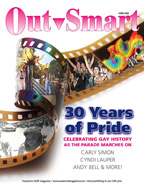 By David Fagan and Skip Teauxmelou
By David Fagan and Skip Teauxmelou
Photos by Dalton DeHart, Blase DiStefano, and Fred Paez
In 1967, Muhammed Ali is indicted for refusing induction into the army, The U.S. Supreme Court declares all state laws prohibiting interracial marriage unconstitutional, Britain’s parliament decriminalizes homosexuality, and a group of women in Houston, Texas, who call themselves The Tumblebugs, are raising money to hire powerhouse attorney Percy Foreman to defend their female friends who have been arrested for wearing fly-front pants in public. Five years later, Texas’ first Pride parade is held in Dallas, and three years after that the South’s oldest GLBT civil rights organization is founded in Houston. When it comes to the gay movement of the ’60s and ’70s, people tend to think in terms of New York City and San Francisco, the cities that drew the headlines. But other communities, including Houston, were no less active in those days.
The Houston Gay Caucus, the precursor of today’s Gay Lesbian Bisexual Transgender Political Caucus (GLBTPC), was founded in 1975, as the first GLBT civil rights organization in the South. In keeping with the spirit of this new politically out organization, its first president was fired from his job for speaking out for gay rights. A year later, Houston’s Pride parade was
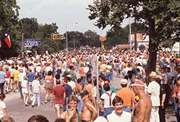
born in the form of a march sponsored by the University of Houston’s Gay Activist Alliance. As a commemoration of the Stonewall Rebellion, the march declared that discrimination against the gay community would be met with resistance. (The Stonewall Rebellion in June 1969 resulted from a raid by NYPD at the Stonewall Inn, a neighborhood bar in New York City’s Greenwich Village. It is universally viewed as the watershed of the Gay Rights movement and is the event that spawned Pride parades initially in NYC, Chicago, Los Angeles, and, today, throughout the world.)
The logistics of that first parade here in Houston had few similarities to those of today’s Pride parades. There were no marching bands or floats, no banners. It was just people—people who had been recruited over the past year, many through the efforts of Ray Hill, one of Houston’s earliest gay activists. Hill targeted the most “obviously gay persons” he could find in Houston’s bars (people who never had to come out of the closet because they didn’t have to—“you could just tell”), the rationale being that these people had the most to lose—and the most to gain.
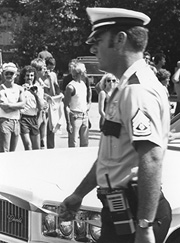
The apex of Houston’s parade is now at Westheimer and Montrose, the main thoroughfares of Houston’s original gay village. But that first Pride parade took to the streets of downtown Houston—and not just any street, but Main Street. The march was permitted by the City of Houston, the required parade-permit fee being waived for the student group sponsor and the necessary insurance being funded by transgender attorney Phyllis Randolph Frye, Dr. Richard O’Brien, and others.
On the Sunday afternoon of the march, a crowd of about 60 men and women gathered in the parking lot of The Exile, a downtown gay bar at 1011 Bell Street (now a parking lot). When the moment to begin the march arrived, they walked the half block to Main, rounded the corner at Simpson’s Diner and stepped out onto Main Street, not knowing what to expect. The marchers moved north, down the south half of Main Street, toward Texas Street where the route would turn and then retrace back down Fannin to Bell. Since it was Sunday, there were few people on the sidewalks in downtown Houston, other than those drawn there by this event. And as the marchers progressed down Main, people standing on the sidewalk began to join them. Soon a chant began among the marchers, “Off of the sidewalk! Into the street!” And as more people stepped off the curb, the marching crowd grew to an estimated 300 to 400.
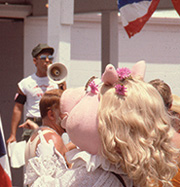
The march was brief—the numbers few by today’s standards—but with each step taken down Main Street, those participants in Houston’s first Pride parade left their footprints on the history, culture, and politics of the City of Houston. One of the participants at that first march was New Orleans native Larry Bagneris, who had seen how the parades of Mardi Gras forged a community identity in his hometown. He expressed his opinion on what a Pride parade should look like and what it might accomplish and found himself spearheading the planning for the Houston Gay Pride Parade.
The parade planned for 1977 was cancelled because of inadequate funding. Had it not been for the emergence of Anita Bryant’s “Save Our Children” campaign, that might have been the end of Houston’s effort at visibility for the near future. On June 16, 1977, nine days after her successful campaign to repeal a Dade County, Florida, ordinance banning discrimination against gay men and lesbians, Bryant was to come to Houston to perform at the State Bar of Texas banquet.
Gary Van Ooteghem of the Gay Political Caucus, Ray Hill of the Houston Human Rights League, and the Reverend Jeri Harvey of the Metropolitan Community Church quickly organized a candlelight protest. Besides carrying candles, many marchers wore black armbands with inverted pink triangles. The marchers gathered for a rally in the parking lot of the Depository II bar on McGowen, then headed downtown at 8 p.m. Informed of the protest march, the City refused to grant a parade permit, which meant the marchers would be confined to the sidewalks, mingling with other pedestrians, stopping for traffic lights, and pausing to “look both ways.” The Houston Police Department prepared for 300 marchers, but by the end of the night more than 4,000 gays, lesbians, and their supporters had joined the protest, marching around the downtown Hyatt Regency Hotel, where the banquet was being held, and ultimately to a protest rally at City Hall.
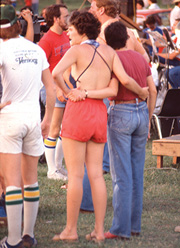
The protest was peaceful, though vocal, and as the sheer size of the demonstration became evident, HPD sent word to the protest organizers for the marchers to take to the street. Soon the streets were a mass of demonstrators singing songs and chanting “Equal Rights Now.” As each wave arrived at the Hyatt, the volume swelled with such intensity that the sound could be heard in the banquet room where Bryant was to appear. Houston’s gay community had made its presence and voice heard.
The noisy demonstration was covered not only by local and state press, but was also broadcast live on NBC national radio via hookup through Houston station KPRC. The air was electrified with a sense of purpose and solidarity, and a sense of community was born in Houston, reflected a few weeks later in the first Gay Pride Rally held in Cherryhurst Park.
(Story continued…)


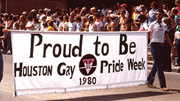







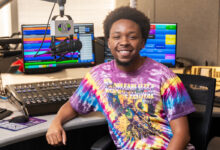

Comments